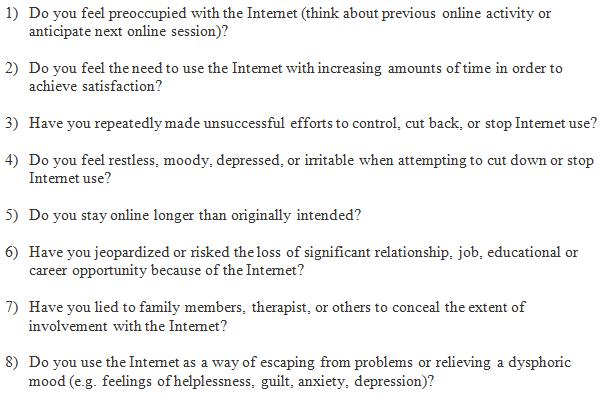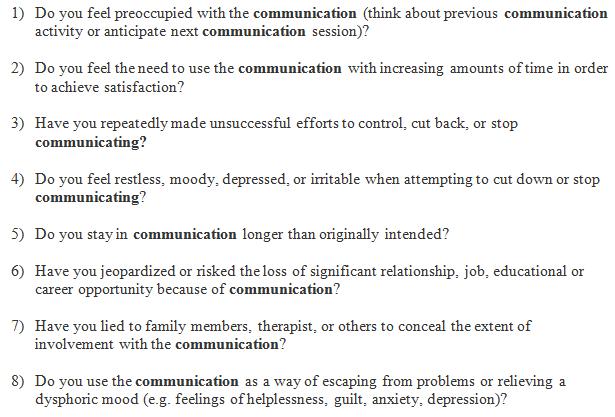SodaHead, an opinion gathering website, recently asked its users about “Internet Addiction.” From user responses (N=602), they produced the infographic below. In the present post, I am not going to discuss this infographic in its own right. Instead, I am going to discuss “Internet Addiction” (from here on referred to as IA) as a condition—one that is slated for inclusion in the upcoming DSM-V. Specifically, I will argue that its existence rests on faulty assumptions, and that it is a problematic diagnostic category.

To deconstruct IA as a diagnostic category, I must begin with a brief discussion on the philosophy of science—specifically addressing the mutually constitutive relationship between research design and social reality. Simply put, no research is objective. The very questions that we ask are bound by the logics of culture, politics, and language—as are the measures we use to answer these questions. Moreover, new studies are rooted in existing research, further limiting the lens with which reality is viewed and understood. In turn, research findings influence how we think about our physical and social world, the language that we use, and the logics with which we understand ourselves and that which surrounds us. IA, as a diagnostic category, a social problem, and a potential identity, must be understood within this context.
So what is IA, and how do you know if you have it? According to Kimberly Young and the Center for Internet Addiction, a person who suffers from IA would answer “Yes” to at least 5 of the following questions:
 The first thing to notice about these diagnostic criteria is the simple substitution of “Internet” for “drugs.” Just like drug addiction, the criteria for IA includes tolerance, withdrawal, loss of control, negative consequences, neglect of other activities, over-expenditure of energy, and a desire to cut down. Here, we see the ways in which new knowledge is deeply rooted in established knowledge. The notion of addiction itself as a medically treatable condition, the criteria by which IA is diagnosed, the treatment prescribed for the Internet Addict (cognitive behavioral therapy), and the definition of the “patient” as someone with a problematic identity, is reified with the official inclusion of IA in the upcoming DSM-V.
The first thing to notice about these diagnostic criteria is the simple substitution of “Internet” for “drugs.” Just like drug addiction, the criteria for IA includes tolerance, withdrawal, loss of control, negative consequences, neglect of other activities, over-expenditure of energy, and a desire to cut down. Here, we see the ways in which new knowledge is deeply rooted in established knowledge. The notion of addiction itself as a medically treatable condition, the criteria by which IA is diagnosed, the treatment prescribed for the Internet Addict (cognitive behavioral therapy), and the definition of the “patient” as someone with a problematic identity, is reified with the official inclusion of IA in the upcoming DSM-V.
This reifying diagnosis, I argue, is problematic in its assumptions. First, it is problematic to treat internet use and mind-altering substances as interchangeable. Drugs change a person’s physiology, tying the person to the substance in a physical way—to the point that stopping can cause serious illness or even death. Though one might argue that engagement with the internet re-shapes synaptic structures and elicits particular emotions and the concomitant release of brain chemicals, stopping internet use “cold turkey” will not cause vomiting or the shakes. The more problematic assumption, however, rests in the incorrect notion of “The Internet” is separate from “real” social life. IA as a diagnostic category assumes that The Internet is a realm of fantasy, an escape, a distraction. In this light, overuse of The Internet disrupts real life and requires rehabilitative treatment.
If we understand the internet as an integral part of social life, however, then a diagnosis of IA makes little sense. If we understand the internet as a means of sociality, a venue for business communications, an outlet for creativity, a source of news gathering and a space of recreation, then indeed, an addiction to internet technologies would be an addiction everyday life. Just as a thought experiment, let us substitute the phrase “communication” for the word “Internet” in the above listed IA criteria:
 Here, we see that some criteria become nonsensical (e.g. criteria 2), and others come to describe healthy social skills rather than practices of the mentally ill (e.g. criteria 8).
Here, we see that some criteria become nonsensical (e.g. criteria 2), and others come to describe healthy social skills rather than practices of the mentally ill (e.g. criteria 8).
The point is twofold: First, if we unproblematically build new knowledge upon existing knowledge, our knowledge structures become narrow, unstable, and difficult to support. Second (and relatedly), Internet Addiction is an unsupportable addition to our knowledge structure. And yet, it is very much a part of our knowledge structure. This is epitomized by inclusion in the DSM, and exemplified in users’ willingness to respond in the SodaHead survey pictured above (along with the unproblematic spread of the results in places like the United Academics blog). IA has indeed infiltrated our social logic. It is a legitimate category with which to define oneself (or define oneself against); it is a legitimate way to make sense of experience; it is a widely shared frame with which to understand uses of technology; AND it will shape how we understand human/technology relationships in the future.
This is not to say that internet and digital technologies (or any technologies) necessarily have a positive relationship with social life and/or mental health. Internet technologies can lead to exploitation and privacy invasion. Internet users might ignore their physical surroundings (including interaction partners) in preference of a glowing screen. Indeed, people can potentially become addicted to digitally mediated pornography, online gaming, or online gambling. But these are not problems caused by the internet. Rather, they are the digital forms of extant social ills. They are the digital manifestations of greed, narcissism, depression, and loneliness. The diagnostic category of Internet Addiction makes the internet a scapegoat for human social problems, and in doing so, it falsely de-couples virtual and actual; it reifies knowledge structures that fail to fit with empirical reality and lived experience; and it promotes treatment protocols aimed at personal troubles without addressing public issues.

Comments 9
Laura Portwood-Stacer — March 20, 2012
Thanks for this post - so important!
For anyone interested in reading further about some of the social/political implications of discursively framing media consumption as addiction, Jason Mittell's, "The Cultural Power of an Anti-Television Metaphor: Questioning the 'Plug-In Drug' and a TV Free America," is a great analysis.
“RealTouch” and Augmented Sexual Interaction » Cyborgology — March 24, 2012
[...] relationships with “real people”. Jenny Davis’s post earlier this week on the “problem with internet addiction” highlights the same issue: the idea that digital interaction is somehow a zero-sum game, wherein [...]
How We Talk About Media Refusal, Part 1: “Addiction” Laura Portwood-Stacer – New York University | Flow — July 29, 2012
[...] in Bergen, Norway claimed to have developed a valid scale for identifying Facebook addiction. Jenny Davis has pointed out how professional medical understandings of media addiction filter down to public [...]
The Problem with Internet Addiction » Cyborgology | The Digital Self | Scoop.it — October 14, 2012
[...] [...]
Refusing the Refusenicks Paradigm » Cyborgology — October 15, 2012
[...] of what the internet is.” Further, on Cyborgology earlier this year, Jenny Davis provides additional critique, looking at how the addiction paradigm wrongly assumes that the Web is separate from everyday [...]
Refusing the Refusenicks Paradigm « n a t h a n j u r g e n s o n — October 30, 2012
[...] of what the internet is.” Further, on Cyborgology earlier this year, Jenny Davis provides additional critique, looking at how the addiction paradigm wrongly assumes that the Web is separate from everyday [...]
The Problem with Internet Addiction | Internet ... — April 16, 2013
[...] SodaHead, an opinion gathering website, recently asked its users about “Internet Addiction.” From user responses (N=602), they produced the infographic below. In the present post, I am not going to discuss this infographic in its own right. [...]
The Problem with Internet Addiction » Cyb... — May 29, 2014
[…] […]